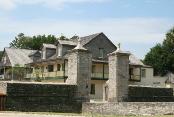Historic District of St. Augustine - St. Augustine, Florida
The Cathedral Basilica
This beautiful cathedral was
begun by the Spanish in 1793
and faces the Plaza de la
Constitucion.
This beautiful cathedral was
begun by the Spanish in 1793
and faces the Plaza de la
Constitucion.
Colonial Architecture
St. Augustine abounds with
original and reconstructed
structures dating from the
Spanish and British eras.
St. Augustine abounds with
original and reconstructed
structures dating from the
Spanish and British eras.
St. Augustine Historic District - St. Augustine, Florida
| St. Augustine Historic District A massive restoration and reconstruction project has brought the old Spanish city of St. Augustine, Florida back to life. |
Colonial Architecture in Florida
Visitors to St. Augustine, Florida are often
literally amazed by the size and scope of the
city's magnificent historic district.
The oldest continually occupied city in the
continental United States, St. Augustine was
founded in 1565 and the city began to take its
present form during the 1590s, well before
the founding of either Jamestown or the
landing of the Pilgrims at Plymouth Rock.
The government and public buildings of the
old city were built around a central plaza, the
Plaza de la Constitucion, which holds the
distinction of being the oldest public park in
the United States. From this plaza, the
streets of St. Augustine spread out in an
ancient grid pattern that is more reminiscent
of an old European city than an American
community.
The community was burned to the ground by
English forces under Governor James Moore
of South Carolina in 1702, although the fort
Castillo de San Marcos withstood a 52 day
siege. Following the devastating attack, St.
Augustine was rebuilt as a walled city and
never fell again.
Because many of its colonial structures were
built of coquina stone, a natural sedimentary
stone quarried on nearby Anastasia Island, a
large number survive to this day. Others have
been reconstructed as part of a massive
community restoration project initiated during
the 1970s.
Historic St. George Street stretches from the
Old City Gate near Castillo de San Marcos
south to the Plaza de la Constitucion and is a
centerpiece of the historic district. Now a
pedestrian walkway, it is lined with original
and reconstructed colonial buildings that
serve as museums, shops, restaurants and
more. The restored district stretches out both
east and west from St. George for block after
block.
At the center of the ancient city, the Plaza de
la Constitucion still functions as the central
plaza of St. Augustine. Facing the plaza can
be found the Cathedrial Basilica and the
Government House, both of which date from
the 1700s, as well as other unique structures.
On the plaza can be seen various
monuments, cannon, a public well dating
from the 1600s and the historic market place.
The historic district continues in all directions
from the Plaza. To the west can be found the
magnificent structures of Flagler College.
Originally constructed as a luxurious hotel
during the late 19th century, the beautiful
campus is now a landmark of the city.
literally amazed by the size and scope of the
city's magnificent historic district.
The oldest continually occupied city in the
continental United States, St. Augustine was
founded in 1565 and the city began to take its
present form during the 1590s, well before
the founding of either Jamestown or the
landing of the Pilgrims at Plymouth Rock.
The government and public buildings of the
old city were built around a central plaza, the
Plaza de la Constitucion, which holds the
distinction of being the oldest public park in
the United States. From this plaza, the
streets of St. Augustine spread out in an
ancient grid pattern that is more reminiscent
of an old European city than an American
community.
The community was burned to the ground by
English forces under Governor James Moore
of South Carolina in 1702, although the fort
Castillo de San Marcos withstood a 52 day
siege. Following the devastating attack, St.
Augustine was rebuilt as a walled city and
never fell again.
Because many of its colonial structures were
built of coquina stone, a natural sedimentary
stone quarried on nearby Anastasia Island, a
large number survive to this day. Others have
been reconstructed as part of a massive
community restoration project initiated during
the 1970s.
Historic St. George Street stretches from the
Old City Gate near Castillo de San Marcos
south to the Plaza de la Constitucion and is a
centerpiece of the historic district. Now a
pedestrian walkway, it is lined with original
and reconstructed colonial buildings that
serve as museums, shops, restaurants and
more. The restored district stretches out both
east and west from St. George for block after
block.
At the center of the ancient city, the Plaza de
la Constitucion still functions as the central
plaza of St. Augustine. Facing the plaza can
be found the Cathedrial Basilica and the
Government House, both of which date from
the 1700s, as well as other unique structures.
On the plaza can be seen various
monuments, cannon, a public well dating
from the 1600s and the historic market place.
The historic district continues in all directions
from the Plaza. To the west can be found the
magnificent structures of Flagler College.
Originally constructed as a luxurious hotel
during the late 19th century, the beautiful
campus is now a landmark of the city.
Gates of St. Augustine
The Old City Gate at the north
end of St. George Street was
built by the Spanish in 1808
during a project to repair the
Cubo Line or town walls.
The Old City Gate at the north
end of St. George Street was
built by the Spanish in 1808
during a project to repair the
Cubo Line or town walls.
To the south can be found additional
structures dating from all eras of the city's
history. Among these is the the Oldest House
in Florida, built in the early 1700s.
Now owned by the St. Augustine Historical
Society, the historic Gonzalez-Alvarez House
was built during the early 1700s. The lower
story of the home is of coquina stone
construction and was built by the Spanish.
The upper floor is wood frame and was
added by the British during the era of the
American Revolution.
The east side of the historic district is limited
by the waterfront, popular for its fresh sea
breezes and scenic beauty both day and
night. Here also is located the historic
Castillo de San Marcos, the massive
Spanish fortress begun in 1672 on the sites
of earlier wooden fortress.
Built of coquina stone, the Castillo was in
reality a castle for the people of St. Augustine.
Large enough to shelter the population of the
entire city during times of attack, it never fell
to an enemy force.
The charming St. Augustine historic district
offers numerous inns, dining establishments
and shops as well as the historic sites and
structures for which it is known.
structures dating from all eras of the city's
history. Among these is the the Oldest House
in Florida, built in the early 1700s.
Now owned by the St. Augustine Historical
Society, the historic Gonzalez-Alvarez House
was built during the early 1700s. The lower
story of the home is of coquina stone
construction and was built by the Spanish.
The upper floor is wood frame and was
added by the British during the era of the
American Revolution.
The east side of the historic district is limited
by the waterfront, popular for its fresh sea
breezes and scenic beauty both day and
night. Here also is located the historic
Castillo de San Marcos, the massive
Spanish fortress begun in 1672 on the sites
of earlier wooden fortress.
Built of coquina stone, the Castillo was in
reality a castle for the people of St. Augustine.
Large enough to shelter the population of the
entire city during times of attack, it never fell
to an enemy force.
The charming St. Augustine historic district
offers numerous inns, dining establishments
and shops as well as the historic sites and
structures for which it is known.
The Government House
Now a visitor center and
museum, the Government
House was built in the years
1706-1713 and served as the
home of Florida's Spanish
governor and the capitol of the
colony.
Now a visitor center and
museum, the Government
House was built in the years
1706-1713 and served as the
home of Florida's Spanish
governor and the capitol of the
colony.
Castillo de San Marcos
Plaza de la Constitucion
Old City Gates of St. Augustine
St. Augustine, Florida
Historic Sites & Points of Interest
Historic Sites in Florida
Explore other Southern Historic Sites
Plaza de la Constitucion
Old City Gates of St. Augustine
St. Augustine, Florida
Historic Sites & Points of Interest
Historic Sites in Florida
Explore other Southern Historic Sites
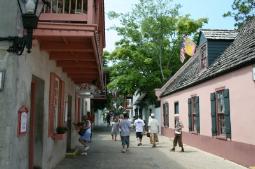
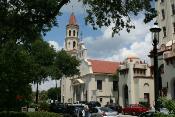
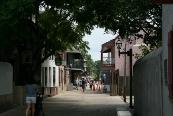
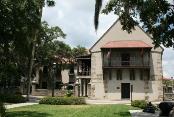

Custom Search
| Copyright 2011 & 2013 by Dale Cox All rights reserved. Last Update: November 13, 2013 |
